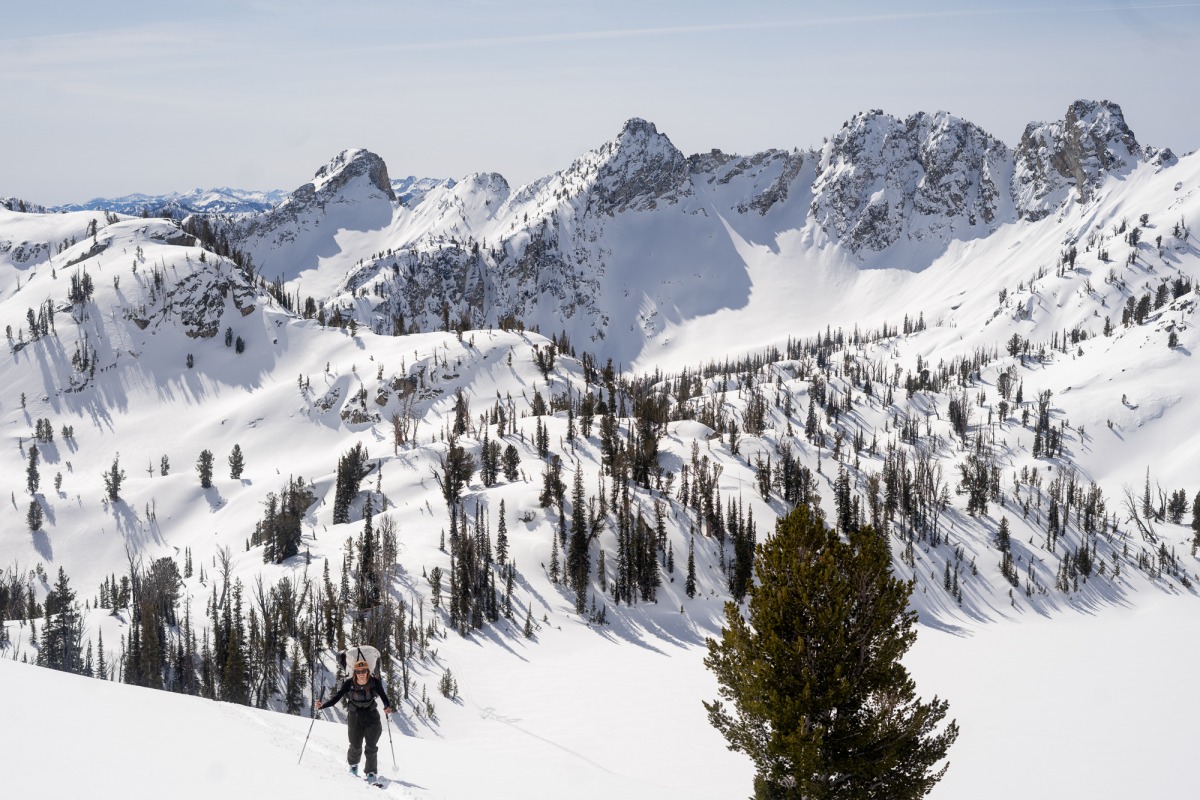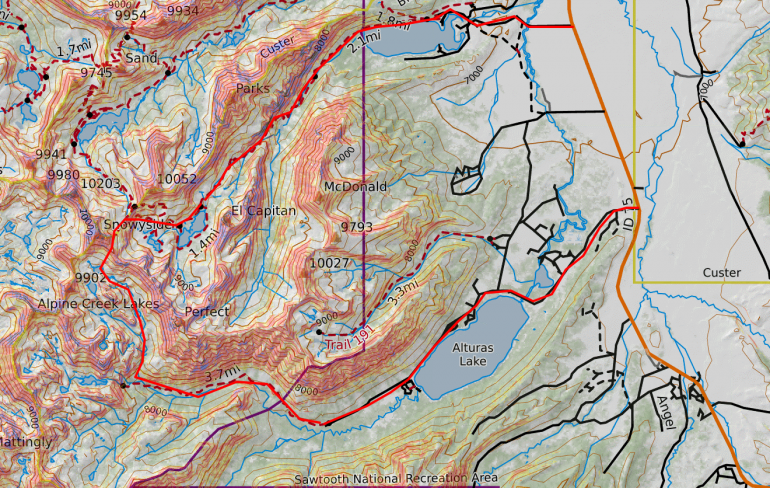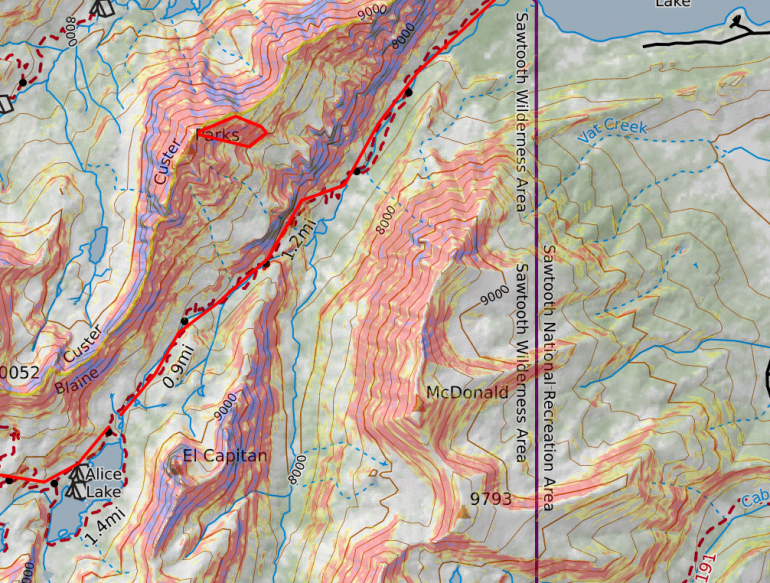
Idaho’s Sawtooth Mountains provide a wide open classroom for adventure and personal growth.
I wake up to water droplets hitting my face. Despite wearing three layers, a hat, and down booties, somehow, I am still cold in my sleeping bag. It’s 7:15 am, first light crests the ridgeline above our tent. I’m camped in a back basin of the Sawtooth Mountains, roughly 12 miles from anything.
“I might be in over my head,” I think to myself as I look over at my two friends, cocooned together and deeply asleep. They don’t look the least bit uncomfortable; meanwhile, I’m wearing all the layers I brought, and I’m shivering. This is my first time winter camping, and I feel grossly underprepared. I both silently chastise myself for not thinking ahead and secretly hope someone else in the group cracks before me.
***
Let me back up and give you a little history.
Though I’d never winter camped before this trip, I’m no stranger to cold weather and long pushes in the mountains. I’ve been in Colorado for a decade and spend most of my days on skis. I’ve done many hut trips, long exploratory ski days, and raced the Grand Traverse from Crested Butte to Aspen four times (including a victory and an epic sufferfest of nearly 16 hours my first year). I have dialed in my layering, am good with my caloric consumption, and generally feel prepared for most anything ski-related… except winter camping, apparently.
As evidenced by the publication of this article, I did not freeze to death in that tent, but I learned much about my gear and limits over those five days.
This experience in the Sawtooths was a healthy reminder that there is always room to grow, even in environments where you already feel comfortable.

A near estimation of the proposed route.

A zoomed in view with a highlighted area where a slide occurred on Parks Peak.
***
It started with a quick text, “Want to do something rad on skis?” my friend asked. Of course, I thought to myself- I always want to ski. We pitched ideas back and forth, scoured maps and dates, and devised a rough plan. Our fishhook-shaped route would cover roughly 35 miles/ 10,000ft over five days and four nights, with one significant mountain saddle to cross into a different basin. Other than that, it seemed pretty standard. The avalanche report was moderate, the weather forecast sable, and I trusted we could navigate any surprises.
Lulled by the forecast of warm, sunny days, we tried to keep our packs as light as possible. I packed like I usually do for a hut trip–food, sleeping bag, headlamp, etc.- all the essentials. I brought some spare clothing items, hand warmers, and a tiny first aid kit.
Initially, we were most concerned with low snow; the Sawtooths had average to below-average snow totals for the year. We assumed we’d be more or less just “out for a stroll” for a few days.
The lack of snow, however, would be the least of our worries.
***
We skinned 12 miles the first day under a cold and snowy sky, something the forecast didn’t predict. I hoped this weather would blow over, as we were banking on sunny days throughout the week to help with navigation and avalanche safety.
It snowed a decent amount that night- which is to say any amount of accumulation was much more than we expected. In the morning, my socks were still wet despite my best efforts to dry them in my sleeping bag, and my boots were hard as rocks. Oh, and I was still cold despite sleeping in every warm item I had. This was going to be a long week.
Lesson #1– Bring more layers than you think (your stuff may not dry the way you planned).
In addition to the unexpected weather, I was concerned with avalanche activity. We’d experienced some whumping while traversing across the bottom of the basin and could see evidence of wet slides on some of the steeper terrain. We’d done our homework on Cal Topo. We studied the slope shading before our departure, but this was a new area for all of us, and we essentially had to make big decisions in real-time with no prior information, no cell service, and a lot of new, unexpected snow.
As the day wore on and we pushed into more consequential terrain, I realized we hadn’t discussed risk tolerance, hazard mitigation, or a safety plan prior to beginning the traverse. This was unlike me, as I am usually a classic “over-communicator,” in most senses. I like to touch base with everyone and ensure the team is on the same page.
In recent years, I’ve grown more comfortable with having tough discussions and speaking my mind in most situations, but here, for some reason, I didn’t. Looking back, I figured we would talk about it at the trailhead, but I think we were all thrown off by the weather and in a hurry to get to our first camp that night.
Lesson #2– Communication is king. Always make time for a discussion.

Big country where Lesson # 2 reigns: Lesson #2– Communication is king. Always make time for a discussion.
***
Like most who recreate in the mountains, I like a healthy dose of risk, but I also pride myself on good communication and group dynamics. There have definitely been times when I’ve bailed on an objective due to concerns that didn’t materialize, but I’d rather come home safe that night and try again another day.
I was along for the ride to see a new area, learn about winter camping, and hopefully make a few good turns. I wasn’t particularly objective-based with this mission and planned to do field assessments and make decisions based on what we saw in the field. I was excited to explore a new area and get some miles on my legs.
Later in the week, on one particular ascent of a peak, we triggered a small R1/D1-1.5 avalanche; one group member was caught and carried. Luckily, he stayed on the surface and was uninjured.
I had a weird feeling about the snow on that aspect while skinning that morning. When presented with the choice to go right on the softer, more sun-baked deep snow or left into the hard, shady face, the voice in my head was telling me to put a booter in the stiffer, shadier snow (despite it looking steeper and more effort to ascend). I didn’t speak up.
Thankfully, this was small in size and outcome. Still, for me, it was monumental and brought me back to the importance of good communication, group dynamics, and encouraging everyone to speak their mind about the day’s plan. My partners’ approach to communication and risk management was quite different from mine, which is something we would have fleshed out had we taken the time to talk before departing.
Lesson #3– Speak your mind, even if it’s unpopular. It’s an “all go, or a no.”
After the slide, we had more of an open dialogue, and our communication improved a bit. I was still uncomfortable voicing a dissenting opinion to theirs but was finding more confidence in speaking out.
By the last night, we were almost out of food. I was so grateful to be returning that next day, as I was physically beat and tired of the constant bone chill. We’d each consumed far more calories than expected (due to the route’s difficulty, unexpected vertical, and cold weather, and were running on fumes for the skin out. Route-finding was tricky, it took longer than we’d expected, and we were all gassed by the time we arrived at the cars.
I’m incredibly grateful we arrived back at the trailhead without injury, as we would have been in a tough spot had something gone wrong. We were exhausted and moving through terrain that was not easy to ski, let alone with heavy packs on our backs. Besides an InReach and a few small items in a first aid kit, we didn’t have any substantial safety gear had something gone wrong. Though professionally, I work as a first responder (and therefore know better), I cut corners to save weight and was banking on us staying safe.
The more I think about it, we lucked out. A little extra weight in food or safety gear will go a long way in an emergency or if the day goes longer than planned.
Lesson #4– Don’t rely on luck or stamina- pack more food and safety gear than you think. You’ll need it if something happens.
In the weeks following, I’ve had time to digest this adventure. It was humbling in ways I didn’t expect and similarly predictable in ways I did. I exhausted myself, saw a stunning part of our country, and was able to explore a new mountain range. I deepened my friendships, tested my limits with temperature and pack weight, and emerged as a stronger, more capable partner in the mountains. Though rough at times, these experiences teach us many important lessons, and I hope to carry those with me as I continue my wanderings.
I’ve been telling stories ever since I could talk. A former Division I swimmer, I ditched the pool for the Rocky Mountains shortly after graduating from the University of North Carolina, armed with a journalism degree and a faint knowledge of how to ski. I quickly fell in love with the mountains and feel happiest when I’m skiing powder, summiting peaks and riding my bike. You can find me scheming up the next big adventure… or the next great meal.
